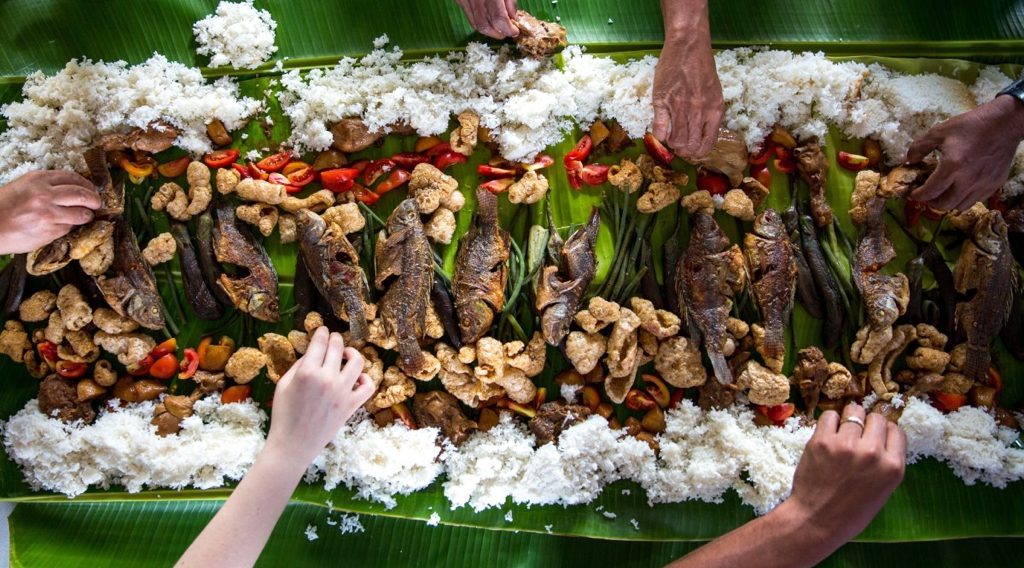Banana leaf rice is not just any normal food you eat. There is an art to it that many do not know of. Learn the tips and tricks of banana leaf rice to impress your family members and friends during the next banana leaf outing.
Know your Banana Leaf A-Z
If you have read our article on the history banana leaf rice, you would have known by now that it is a traditional method of serving rice that was brought over to Malaysia during the migration of South Indians in the 1900s. A unique dining experience, it will tickle your taste buds with all kinds of flavours, while filling your tummy with contentment.
Now, The order and type of foods served in a banana leaf varies from culture to culture. In general, the following is practised in the Southern Brahmin style whereby there are 8 components that make up a banana leaf rice serving which are;
a) Banana leaf
– With its high content of polyphenols, a natural antioxidant that can add more nutritional value to the food served on it. Besides, it keeps the food fragrant and make it more appetising to the eater.
b) Curry
– Nothing goes best with banana leaf rice other than curry. Most places will offer a range of curries, with a choice of chicken, fish or dhal.
c) Assorted Vegetables
– Usually, three different vegetables will be served on the top half of the leaf and consist of a combination of cucumber raita, spinach, beans, cabbage, potatoes and chutney.
d) Side Dishes
– If vegetables leave you dissatisfied, side dishes such as mutton curry, fried squid, chicken 65 and fried fish can be ordered to make your dining experience more filling.
e) Rasam
– This spicy and sourish soup helps to stimulate the appetite and aids digestion.
f) Tairu
– If you are not a fan of spice, this condiment made of fresh yogurt will help tones down the spiciness of other dishes.
g) Dried Chillies
– If you fill there is no heat for you to further enjoy your banana leaf rice, this crispy, salty dried chillies will add an extra kick.
h) Papadam
– This thin yet large chips made of lentils and spices adds the crunch that is missing in the dish.
Look at the Broader Side of Life
Before your food is served, the waiter or server will first come with a piece of banana leaf. However, have you noticed how the leaf is placed?
There is a significance to the placement or positioning of the leaf. It is placed in a way that the broader side comes on the right. This is because Indians eat on the right hand (eating with left hand is frowned upon due to historical issues of hygiene) and having the biggest part of the leaf close to the right hand makes it practical to move food from the leaf to the mouth. You would have never guess that, huh, if we do not inform you of this piece of gold?
Season to Your Taste
Some banana leaf rice joints respect everyone’s personal taste in food. Some love their food to be spicier, some saltier and some sweeter. Therefore, they will placed salt at the left side of the leaf for the diner to season his/her food according to his/her taste). Condiments such as gravy, pickle and curry are kept on the right which are more accessible. Why? Read the paragraph above. However, salt is not always provided since most banana leaf rice places cook their food with enough salt to give you high blood pressure with just one mouthful.
The Separation between Wet and Dry
As we mentioned earlier, this traditional Indian dish is an art form by itself. If you find it surprising to even have a certain ‘feng shui’ in placing the banana leaf, boy, are you going to be surprise even more!
The components of a banana leaf rice are divided into wet and dry items. Most of the wet items such as the payasam and pachadi are served on the far left of the top half of the leaf so it can be as far as possible from the diner. Meanwhile, the dry items such as the rice and papadam are usually served on the bottom side. The reasoning behind this is very logical. Liquids from the payasam and pachadi can flow towards the corner and you do not want it turning everything soggy. The rice is turned into a makeshift wall that prevents any gravy from the payasam and the pachadi to mix and ruin the flavour of the curry.
Let’s Begin with Something Sweet
When hungry, you rarely pay attention to anything else other than the rice and curry placed on the leaf. That is why, there are times you become confused and lost when figuring out how to eat the rest of the items placed on your banana leaf thus, ruining your eating experience. The first two items that are usually served first are the sweets or traditional desserts, namely the kesari and pachadi.
For you Anglophiles (look it up!) you might not understand why desserts are served first. Indians equate sweets to good news and in this case, the sweets are given as a sign for you to start your meal on a positive note. However, this does not mean you do not get to have a proper dessert at the end of your meal. A small bowl of payasam or curd are usually given after you finish your meal as a sign that your meal is now complete.
So, there you go, people. These are the tip and tricks to make your banana leaf brunch a more memorable experience and an enjoyable one to boot! Share this little gold of information with your family and friends and see how their look of surprise changes to the one of bliss.

